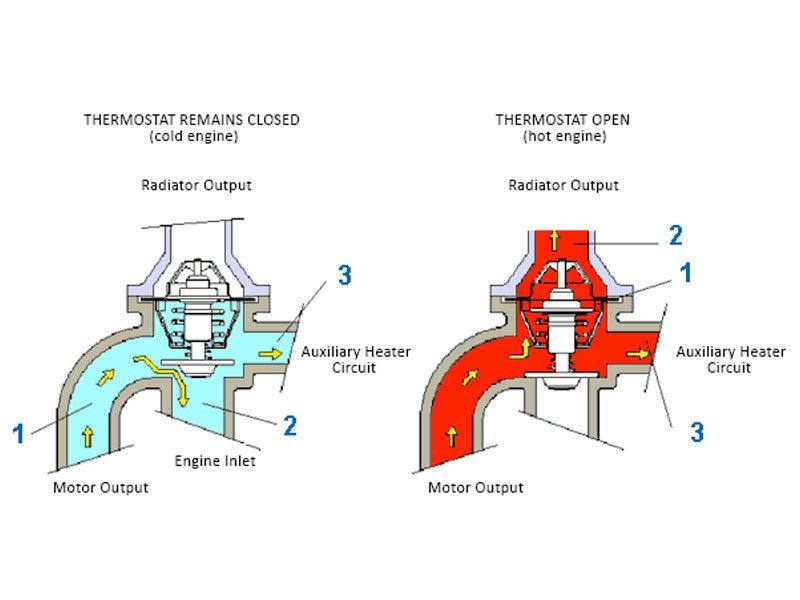Radiator, Thermostat And Pressure Cap
FEBRUARY 19, 2016

A radiator, thermostat and pressure cap is a heat exchanger. Its design is to transfer heat from the coolant flowing through the engine to the cooler air blown by the radiator fan.
Most modern vehicles have aluminum radiators. These radiators are created by brazing thin aluminum fins to flattened aluminum tubes. The coolant flows through many tubes mounted in a parallel arrangement. The fins conduct the heat from the tubes before it is sent off to cool in the air flowing around in the radiator.
The tubes sometimes have a type of fin inside them called a turbulator, which adds to turbulence to the fluid flowing through the tubes. If the fluid flowed smoothly, only the fluid touching the sides would be cooled directly. And if that fluid cools down quickly, then less heat will be transferred. By creating turbulence in the tube, all of the fluid mixes better and helps transfer more heat.
Radiators typically have tanks on each side, and inside each tank is a transmission cooler. You can see in the picture the inlet and outlet, where transmission oil enters the cooler. The transmission cooler is like a radiator within a radiator. But, instead of dissipating heat with moving air from the fan, the oil exchanges heat with the coolant in the radiator.
Pressure Cap
Cutaway of pressure cap and reservoir.
The radiator cap actually raises the boiling point of your coolant by about 45 F (25 C). How does this happen? Just as a pressure cooker increases the boiling temperature of water, this lid is actually more like a pressure release valve that increases the boiling point by pressurizing the system.
When coolant warms, it expands, creating pressure. The pressure can only escape through this cap, so the setting of the spring determines the maximum pressure in the system. When the pressure reaches about 15 psi, the valve opens, so coolant can escape and flow through the overflow tube into the bottom of the overflow tank. This also keeps air out of the system.
When the radiator cools down again, a vacuum is made that pulls open another valve, drawing water in from the bottom of the overflow tank to replace the water that was lost.
The open and closed positions of a thermostat.

Thermostat
The thermostat’s primary job is to allow the engine to heat up quickly and then to maintain that engine at a constant temperature. It does this by controlling the amount of water going through the radiator. At low temperatures, the outlet to the radiator is closed — so all the coolant is recycled back through the engine.
Once the coolant temperature reaches between 180 and 195 F (82 – 91 C), the thermostat begins to open, permitting fluid to flow through the radiator. When the coolant reaches 200 to 218 F (93 – 103 C), the thermostat draws wide open. To watch it in person, it almost looks like it moves by magic.
The thermostat contains a small cylinder located on the engine-side of the device. This cylinder is full of wax that will melt at about 180 F (different thermostats will vary). A rod attached to the valve presses into this wax, so when the wax melts and expands, the rod is pushed out of the cylinder and the valve opens. If you have ever read How Thermometers Work and tried the experiment with the bottle and the straw, you have observed this neat process — the wax seems to grow because it is changing from a solid to a liquid state, in addition to expanding from the heat.
This same technique is used in automatic openers for greenhouse vents and even skylights. But in those devices, the wax melts at a much lower temperature.
More information on Cooling System and Heater:
More Services we offer:
Loading ...
Missing business hours data / Error occurred while getting the data.
Our Location
Have Trouble Finding Us?
Loading ...
Missing nap lines data / Error occured while getting the data.
